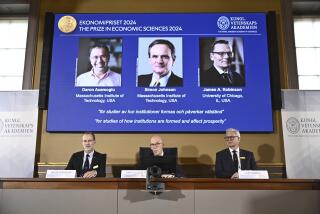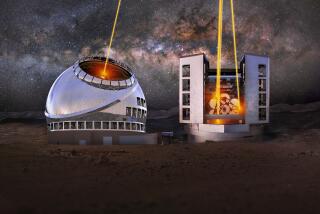How the U.S. gave up on Nobel Prize research
This week’s award of the Nobel Prize in physics to Peter Higgs of the University of Edinburgh and Francois Englert of the Free University of Brussels is a reminder of how the U.S. blew the chance to confirm their theory of the “Higgs boson.”
The confirmation came from the Large Hadron Collider at the European Center for Nuclear Research, or CERN. The LHC reigns as the world’s most powerful particle accelerator only because the U.S. Congress, in a sadly cheeseparing mood, canceled the the Superconducting Super Collider, or SSC, in 1993. That’s as good an example of America’s shortsightedness in promoting basic science as you can find.
Let’s ask Nobel laureate Steven Weinberg of the University of Texas to tell the story. As Weinberg related last year in the New York Review of Books, the SSC project was launched in 1980 to build a device that could accelerate particles to 20 trillion electron-volts. That’s three times the energy that the Large Hadron Collider can produce even today.
After more than 10 years of preparation and the expenditure of $2 billion, Texas was chosen as the site for the vast machine. Then Congress pulled the plug.
“Spending for the SSC had become a target for a new class of congressmen elected in 1992,” Weinberg wrote. “They were eager to show that they could cut what they saw as Texas pork, and they didn’t feel that much was at stake.”
Spin-offs might have changed their mind, but “spin-offs can’t be promised in advance.”
Weinberg recalls one telling encounter with a congressman who opposed the SSC. “He said that he wasn’t against spending on science, but that we had to set priorities. I explained that the SSC was going to help us learn the laws of nature, and I asked if that didn’t deserve a high priority. I remember every word of his answer. It was ‘No.’”
That defines the narrow-mindedness of American politicians today. The SSC was the latest example of Big Science, the industrial-scale research that is necessary in many advanced fields, such as high-energy physics or molecular biology.
Big Science is an American invention. It was pioneered at Berkeley by Ernest O. Lawrence, the creator of the cyclotron, which is the direct forebear of both the LHC and the SSC. Lawrence (who is the subject of my next book), is known today largely as the namesake of the Lawrence Berkeley and Lawrence Livermore national laboratories. He was a genius at obtaining funding from public sources such as the state and federal governments, as well as private foundations and industry. Without their support his cyclotron might never have come into existence.
Lawrence understood that each new discovery with cyclotrons, which soon became standard equipment at major research universities, spurred the need for bigger and better machines, which made new discoveries requiring yet another generation of equipment. But he and his colleagues knew that the human quest for knowledge is unending.
Unless it runs into a budget-cutting Congress. Weinberg observes that the crisis in scientific funding goes beyond the collider: “In the past decade, the National Science Foundation has seen the fraction of grant proposals that it can fund drop from 33% to 23%.”
With its enormous power, the SSC would almost certainly have confirmed the Higgs boson before CERN. (It’s proper to observe that this year’s Nobel went to the theorists behind the Higgs, rather than the confirmation team at CERN.) But the confirmation of the Higgs boson, which gives mass to electrons and quarks, the building blocks of nature, is only an intermediate step in a quest for basic knowledge that may truly be never-ending. Among the elusive quarries is the secret of gravitation, a law of nature that also deserves a high priority.
And that means physicists will need more support from their governments. “That is going to be a very hard sell,” Weinberg wrote last year. He’s right. But if the United States is to maintain -- no, regain -- its proper position as the world center of scientific research, we should hope he’s wrong.
More to Read
Sign up for Essential California
The most important California stories and recommendations in your inbox every morning.
You may occasionally receive promotional content from the Los Angeles Times.











